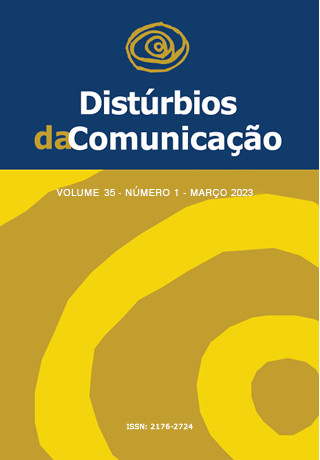Contribution of auditory steady state evoked potential to the election of cochlear implantation or hearing aid for children with hearing impairment
DOI:
https://doi.org/10.23925/2176-2724.2023v35i1e56757Keywords:
Auditory evoked potentials, Hearing loss, Child, HearingAbstract
Introduction: Hearing impairment in children debilitates the acquisition and development of oral language, which can be minimized with diagnosis and confirmation of deafness in the first months of life. Auditory Steady State Evoked Potential (ASSEP) analysis stands out from others auditory evoked potentials due to the ease of recording, objectivity of the answers, stimulation of several frequencies simultaneously, in both ears, besides the identification of residual hearing. Purpose: Determine the contribution of the ASSEP for the therapeutic definition (election of cochlear implantation or hearing aid device) in hearing rehabilitation of children. Methods: The records of 20 children aged one month to three years with severe or profound bilateral neurosensory hearing loss, who were submitted to ASSEP and specific frequency brainstem auditory evoked potential (BAEP) analysis were analyzed. Both tests performed at frequencies of 500 Hz and 2000 Hz using the equipment Smart-EP Intelligent Hearing Systems®. Results: There was difference between the exams regarding the occurrence of residual hearing, since a significant number of individuals had absent responses on the BAEP and present responses on the ASSEP. There was no association between the presence of residual hearing, degree of hearing loss and the child’s age with the type of therapeutic intervention. Conclusion: The presence of residual hearing, classification of the degree of loss and child’s age exerted no influence on the final conduct.
Downloads
References
Linares AE, Costa Filho AO, Martinez MA. Auditory steady state response in pediatric audiology. Braz J Otorhinolaryngol.2010; 76 (6) :723-8.
Joint Committee on Infant Hearing. Year 2007. Position Statament: principles and guidelines for early Hearing detection and intervention programs. Pediatrics, 2007; 20(4): 898-921.
Ribeiro LS. Achados do potencial auditivo de estado estável na neuropatia auditiva: Revisão sistemática. [dissertação]. Universidade Federal de Sergipe; 2019.
Chou Y-F, Chen P-R, Yu S-H, Wen Y-H, Wu H-P. Using multi-stimulus auditory steady-steate l.2012; 269 (1): 73-9.
Lima et al. O implante coclear em crianças com surdez pré-lingual: revisão de literatura. Research, Society and Development, v. 10, n. 16, e223101623852, 2021. http://dx.doi.org/10.33448/rsd-v10i16.23852.
Oliveira, LC. Caracterização dos limiares dos potenciais evocados auditivos de estado estável nos primeiros seis meses de vida [dissertação]. Faculdade de Odontologia de Bauru Universidade de São Paulo; 2012.
Ramos et al. Evaluation of residual Hearing in cochlear implants candidates using auditory steady-steate response. Acta Oto-Laryngologica.2015; 135: 246-253.
Usami et al. Hearing preservation and clinical outcome of 32 consecutive electric acoustic stimulation (EAS) surgeries. Acta Oto-Laryngologica.2014; 134(7): 717-27.
Carnaúba ATL. Desenvolvimento e padronização de um estímulo verbal utilizado para evocar potenciais auditivos de estado estável. [tese]. Universidade Federal de Alagoas; 2018.
Stapells DR. Auditory brainstem response assessment of infants and children. Seminars in Hearing.1989. Vol.10; n3; 229-251.
Luiz CBL, Garcia MV, Azevedo MF. Potencial Evocado Auditivo de Estado Estável em crianças e adolescentes. CoDAS. 2016; 28(3): 199-204.
Van Maanen A, Stapells DR. Normal Multiple Auditory Steady-State Response Thresholds to Air-Conducted Stimuli in Infants. J AmAcadAudiol. 2009; 20: 196–207.
Field A. Discovering Statistics Using IBM SPSS Statistics. 5th ed. 2017; California: SAGE Publications. 1070 p.
Northern JL, Downs MP. Hearing in children. 3rd ed. Baltimore: Williams e Wilkens; 2002.
Brasil. Ministério da Saúde. Secretaria de atenção à saúde. Departamento de atenção especializada e temática. Coordenação Geral de Média e Alta Complexidade. Diretrizes Gerais para Atenção Especializada às Pessoas com Deficiência Auditiva no Sistema Único de Saúde; Brasília, 2014. Disponível em: http://bvsms.saude.gov.br/bvs/publicacoes/diretrizes_gerais_atencao_especializada_pessoas_deficiencia_auditiva_SUS.pdf
Sousa et al. Longitudinal Comparison of Auditory Steady-State Evoked Potentials in Preterm and Term Infants: The Maturation Process. Int Arch Otorhinolaryngol.2017; 21: 200–205.
Pinto MM et al. Idade no diagnóstico e no início da intervenção de crianças deficientes auditivas em um serviço público de saúde auditiva brasileiro. Arq. Int. Otorrinolaringol. 2012; 16(1): 44-49.
Lewis DR, Marone SAM, Mendes BCA, Cruz OLM, Nóbrega M. Comitê multiprofissional em saúde auditiva – COMUSA. Braz J Otorhinolaryngol. 2010; 76(1): 121-8.
Pinto DG. Respostas auditivas de estado estável em crianças de 6 a 48 meses [tese]. Recife: Universidade Federal de Pernambuco; 2016.
Nikolopoulos TP, Vlastarakos PV. Treating options for deaf children; Early Human Development; 2010; (86) 669–674.
Leifer et al. Comparison of auditory evoked potentials of steady-state and potentials evoked by auditory brainstem response in infants with specific frequency hearing loss. int. arch. otorhinolaryngol. 2012; 16 (suppl. 1):26
Rodrigues GI. Potenciais evocados auditivos de estado estável em crianças com perda auditiva neurossensorial [dissertação]. São Paulo: Pontifícia Universidade Católica de São Paulo; 2009.
Speri MRB. A criança com deficiência auditiva: da suspeita ao processo de reabilitação fonoaudiológica. 2013; Revista Verba Volant; vol.4 nº1; jan-jun.
Cavanaugh MCV. Intervenção precoce na deficiência auditiva: repercussões no desenvolvimento de habilidades auditivas, percepção e produção de fala [tese]. São Paulo: Pontifícia Universidade Católica de São Paulo; 2014.
Ferreira et al. A surdez neurossensorial na criança: adaptação protética versus implante coclear. 2012; Rev. Portuguesa de otorrinolaringologia e cirurgia cérvico-facial; vol. 50 nº4; dezembro.
Tarawneh HY et al. Comparison of Auditory Steady-State Responses with Conventional Audiometry in Older Adults. Front. Neurol. 13:924096. doi: 10.3389/fneur.2022.924096.
Stapellset al. Current status of the auditory steady state responses for estimating an infant’s audiogram. In Seewald, RC; Bandford J (Eds). A sound foundation through early amplfiication. Chicaco: Fhonak, 2005. P. 43-59.
Silva DPC, Ribeiro GE, Montovani JC. Resultado do PEATE e resposta auditiva de estado estável em lactentes com e sem falha na TANU. Distúrb. Comum, São Paulo, 33 (2): 339-348, junho; 2021.
Almeida GFL. Implante coclear bilateral sequencial: Resultados em crianças e adolescentes. [dissertação] São Paulo: Faculdade de Medicina da Universidade de São Paulo; 2018.
Downloads
Published
Issue
Section
License
Copyright (c) 2023 Gabriela Regina Sampaio, Elaine Colombo Sousa, Marisa Frasson Azevedo

This work is licensed under a Creative Commons Attribution 4.0 International License.









